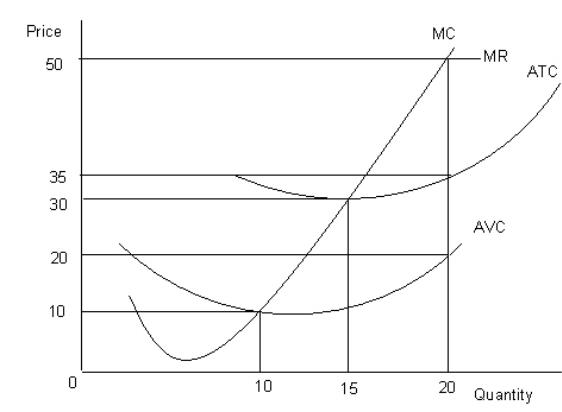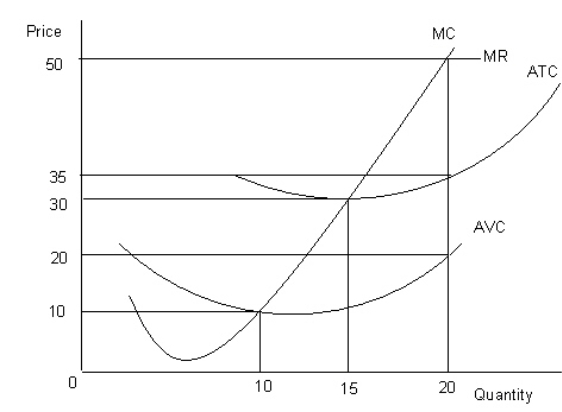B) False
Correct Answer

verified
Correct Answer
verified
Multiple Choice
The table given below shows the price of each unit of the product manufactured by a firm and the marginal cost of producing different units of the output. Table: 23.1
 According to the information in Table 23.1, the marginal revenue of the firm:
According to the information in Table 23.1, the marginal revenue of the firm:
A) is equal to the marginal cost at each level of output.
B) is equal to price times output.
C) is equal to price times marginal cost.
D) is equal to $1 at all levels of the output.
E) decreases with an increase in output.
G) B) and E)
Correct Answer

verified
Correct Answer
verified
Multiple Choice
Which of the following is true of the model of perfect competition?
A) There is a high degree of product differentiation.
B) Consumers do not have adequate information concerning the prices and quality of products in the market.
C) There are significant barriers to entry and exit.
D) There are only a few, large firms in the market.
E) An individual firm cannot affect the market price.
G) None of the above
Correct Answer

verified
Correct Answer
verified
Multiple Choice
A perfectly competitive firm incurs loss in the short run if at the profit maximizing level of output:
A) the marginal revenue curve lies below the marginal cost curve.
B) the marginal revenue curve lies above the average revenue curve.
C) the average cost curve lies below the average revenue curve.
D) the average revenue curve lies below the average cost curve.
E) marginal revenue curve lies above the marginal cost curve.
G) A) and D)
Correct Answer

verified
Correct Answer
verified
Multiple Choice
At the twenty-fifth anniversary of the Woodstock Festival in 1994, there were many vendors who sold tie-dyed t-shirts.No matter where one went, each vendor was selling these t-shirts for $15 apiece.Which market structure model would best characterize such a situation?
A) Perfect competition
B) Monopolistic competition
C) Monopoly
D) Oligopoly
E) Duopoly
G) A) and D)
Correct Answer

verified
Correct Answer
verified
Multiple Choice
In the short run, the firm's break-even point is:
A) the minimum point of the firm's demand curve.
B) the minimum point of the firm's average-total-cost curve.
C) the minimum point of the firm's average-variable-cost curve.
D) the minimum point of the firm's marginal-cost curve.
E) the minimum point on the average-fixed-cost curve.
G) A) and D)
Correct Answer

verified
Correct Answer
verified
True/False
Under perfect competition, existing firms leave the market in the long run if the price falls below total fixed cost.
B) False
Correct Answer

verified
Correct Answer
verified
Multiple Choice
A perfectly competitive firm decides to shut down if:
A) the price falls below the average-total-cost.
B) average revenue falls below the average-variable-cost.
C) the price falls below the marginal cost.
D) the average revenue curve lies below the marginal cost curve.
E) the total revenue is less than total cost.
G) A) and C)
Correct Answer

verified
Correct Answer
verified
Multiple Choice
The following figure shows equilibrium at the industry and firm level. Figure 23.6  In the figure,
S1, S2, S3 are the market supply curves.
D1 and D2 are the market demand curves.
MC is the marginal cost curve of the firm.
MR1 and MR2 are the marginal revenue curves of the firm.
ATC is the average-total-cost curve of the firm.
According to Figure 23.6, a shift of the S curves in the graph on the left side represents:
In the figure,
S1, S2, S3 are the market supply curves.
D1 and D2 are the market demand curves.
MC is the marginal cost curve of the firm.
MR1 and MR2 are the marginal revenue curves of the firm.
ATC is the average-total-cost curve of the firm.
According to Figure 23.6, a shift of the S curves in the graph on the left side represents:
A) an increased supply because the firm produces more.
B) an increased supply because more firms are producing.
C) an increased supply resulting from a larger number of customers.
D) an increased supply resulting from a lower demand.
E) an increased supply resulting from a lower price.
G) A) and B)
Correct Answer

verified
Correct Answer
verified
Multiple Choice
At an output level above the profit-maximizing one for a perfectly competitive firm, a reduction in output will:
A) reduce total revenue more than total cost.
B) reduce total cost more than total revenue.
C) increase total revenue more than total cost.
D) increase total cost more than total revenue.
E) decrease total revenue and total cost by the same amount.
G) All of the above
Correct Answer

verified
Correct Answer
verified
Multiple Choice
Graphically, producer surplus is the area:
A) above the equilibrium price and below the demand curve.
B) below the equilibrium price and below the supply curve.
C) above the supply curve and below the demand curve.
D) below the equilibrium price and above the supply curve.
E) below the equilibrium price and above the demand curve.
G) All of the above
Correct Answer

verified
Correct Answer
verified
True/False
If at the profit maximizing level of output, the AR curve lies below the ATC curve in the short run, the firm is earning positive economic profit.
B) False
Correct Answer

verified
Correct Answer
verified
Multiple Choice
One method that firms in many nations use to exit the market is the use of:
A) antitrust laws.
B) the uniform commercial code.
C) bankruptcy laws.
D) statutes laws.
E) the federal code.
G) C) and E)
Correct Answer

verified
Correct Answer
verified
Multiple Choice
If the market price of oats is $2.5 per bushel and a farmer decides to sell at $2.8 per bushel, he is likely to sell:
A) more than 5 bushels per day.
B) more than 10 bushels per day.
C) less than 5 bushels per day.
D) 10 bushels per day.
E) nothing.
G) A) and E)
Correct Answer

verified
Correct Answer
verified
Multiple Choice
The table given below shows the price of each unit of the product manufactured by a firm and the marginal cost of producing different units of the output. Table: 23.1
 Refer to Table 23.1.If the market price of the good falls to $0.80 per unit, the firm:
Refer to Table 23.1.If the market price of the good falls to $0.80 per unit, the firm:
A) should decrease its output to seven units.
B) should decrease its output to seven Units.
C) should increase its output to ten units.
D) should produce nine units.
E) should keep its output level unchanged.
G) A) and B)
Correct Answer

verified
Correct Answer
verified
Multiple Choice
Which of the following statements concerning perfect competition is not true?
A) Firms are price takers.
B) The demand curve facing the individual firm is horizontal.
C) The firm's demand curve is identical to its marginal revenue curve.
D) The firms produce differentiated products.
E) If the firm raises its price, it will lose all of its customers.
G) A) and D)
Correct Answer

verified
Correct Answer
verified
Multiple Choice
The figure given below shows the revenue and cost curves of a perfectly competitive firm. Figure 23.2  MC: Marginal cost curve
MR: Marginal revenue curve
ATC: Average-total-cost curve
AVC: Average-variable-cost curve
Refer to Figure 23.2.What is the profit-maximizing price and output level?
MC: Marginal cost curve
MR: Marginal revenue curve
ATC: Average-total-cost curve
AVC: Average-variable-cost curve
Refer to Figure 23.2.What is the profit-maximizing price and output level?
A) $35 and 10 units
B) $50 and 15 units
C) $50 and 20 units
D) $20 and 20 units
E) $35 and 20 units
G) B) and E)
Correct Answer

verified
Correct Answer
verified
Multiple Choice
The figure given below shows the revenue and cost curves of a perfectly competitive firm. Figure 23.2  MC: Marginal cost curve
MR: Marginal revenue curve
ATC: Average-total-cost curve
AVC: Average-variable-cost curve
Refer to Figure 23.2.What is the firm's total fixed cost at the profit-maximizing output level?
MC: Marginal cost curve
MR: Marginal revenue curve
ATC: Average-total-cost curve
AVC: Average-variable-cost curve
Refer to Figure 23.2.What is the firm's total fixed cost at the profit-maximizing output level?
A) $400
B) $300
C) $600
D) $450
E) $500
G) A) and D)
Correct Answer

verified
Correct Answer
verified
Multiple Choice
Under the long-run equilibrium for perfectly competitive markets without any government intervention:
A) producer surplus is greater than consumer surplus.
B) consumer surplus is greater than producer surplus.
C) the sum of consumer and producer surplus is maximized.
D) consumer surplus is maximized.
E) producer surplus is maximized.
G) A) and C)
Correct Answer

verified
Correct Answer
verified
True/False
Economic efficiency is achieved when the price of a unit of a commodity is equal to the marginal cost of producing that unit.
B) False
Correct Answer

verified
Correct Answer
verified
Showing 41 - 60 of 135
Related Exams